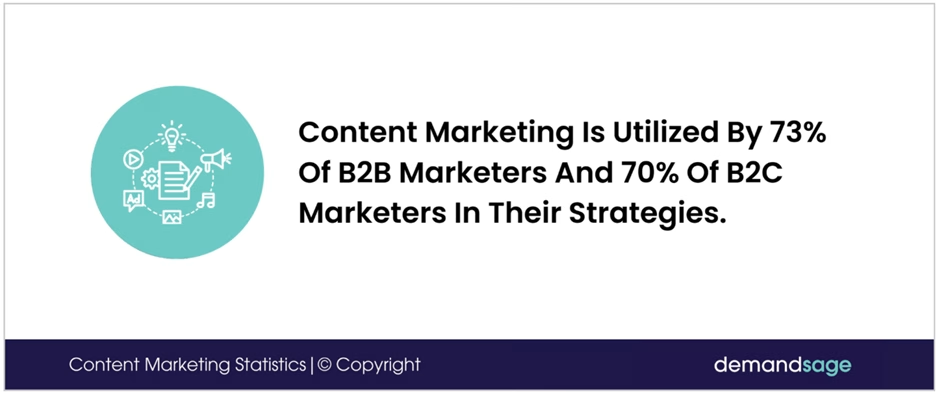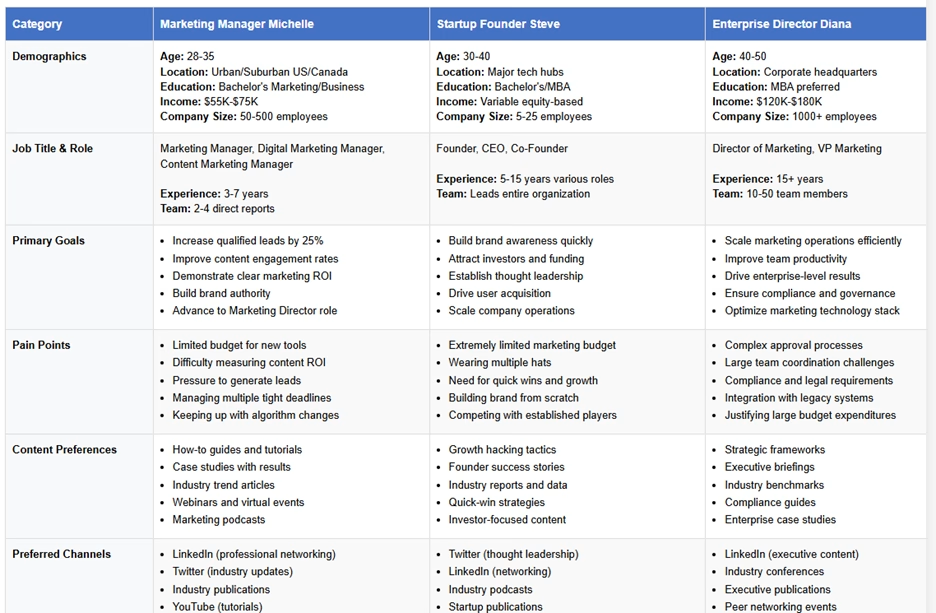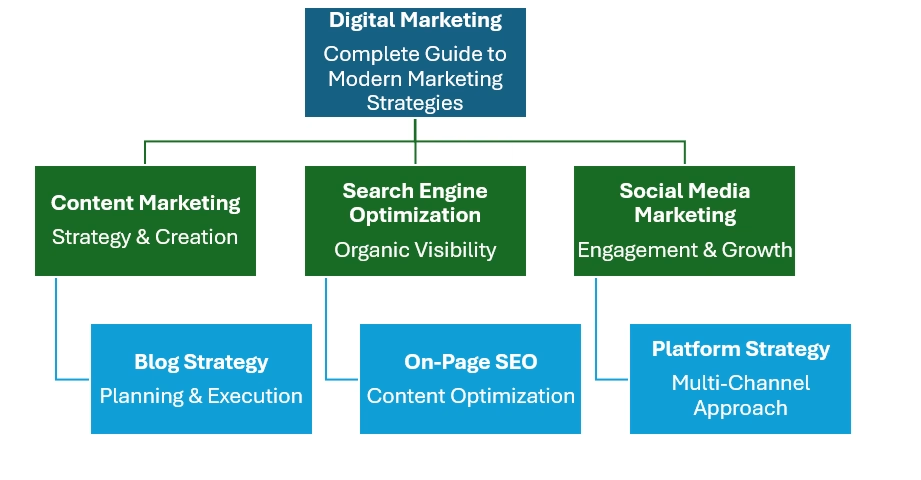Content and Strategy: The Complete Guide to Building High-Impact Content Programs in 2025
Written by David L Hicks – July 28th, 2025
Creating content without a strategy that addresses user needs and pain points is like sailing without a compass; you might move forward, but you’ll likely end up lost. Many organizations struggle with this disconnect. They produce mountains of quality content but see minimal results because their content lacks strategic direction.
The relationship between content and strategy isn’t just meaningful—content strategists must achieve business success. When these two elements work in harmony, they create a powerful process that drives engagement, builds trust, and ultimately converts audiences into loyal customers.
In this comprehensive guide, we’ll explore how to bridge the gap between content creation and strategic thinking to build a strong content strategy. In the end, your content strategy should transform your content efforts from scattered activities into a cohesive, results-driven program.
Table of Contents
ToggleUnderstanding the Content and Strategy Connection
As with learning anything, understanding the basics is crucial for having a clear idea of your content, and strategy is essential. When it comes to your content and strategy, it’s all about understanding their connection.
What Makes Content Strategic?
Your content is strategic due to its importance to your organization’s bottom line and its alignment with your business objectives. Without high-quality content, it becomes really hard for your organization to reach a wider audience. The more people you’re able to get to view your content, the higher the probability of growth. The importance of having a content strategy is proven by the fact that currently 82% of companies use content marketing, with expected growth year to year. 73% of B2B and 70% of B2C marketers use content marketing as part of their marketing strategy.

(Source – Demandsage)
Your content can be divided into various forms of content, including:
- Written blog post
- Podcast
- Videos
- Email newsletters
With the various types of content, you can build a strategy that focuses on different sections of your audience. Each type of content can cater to what resonates with them the best. For example, if you’re a B2B SaaS company, your audience may enjoy reading your blog posts instead of listening to your podcasts.
Building a Content Strategy
Building a content strategy isn’t just about deciding what to write next; it’s about creating a comprehensive roadmap that aligns your content efforts with your business objectives and audience needs.
Understanding Your Business Objectives and Establishing Clear Content Goals
In order to build an effective content strategy, it starts with understanding your organization’s business objectives to create a strong foundation. Once you have an understanding of your business objectives, you can set your goals. Your goals are based on your organization’s business objectives. Your goals ultimately shape your content strategy.
Content Strategy Alignment with Business Objectives and KPIs
Your content is only as strong as its alignment with your business objectives and goals. Without content aligned with your brand, the risk of your content strategy being unsuccessful increases.
In order to measure the success of your content strategy, you have to develop key performance indicators (KPIs). KPI’s are measurable values that show how effectively an organization is achieving its business objectives. For example, your content’s KPIs on your website include:
- Page views
- Time on page
- Clicks
- Emails opened
In order to properly measure them within your content workflow, it’s recommended that you review them periodically. Depending on your organization’s size, you should try to assess them quarterly. Assessing them quarterly will allow you to measure the success of your content strategy. Periodic assessment also enables you to make changes to your content strategy depending on the results of your evaluation.
Creating Audience Personas and Content Journey Maps
Once you have your goals and have aligned them with your business objectives, it’s time to create your audience persona and content journey maps. An audience persona is a bio that explains your core audience. An example of an audience persona chart is shown below.

Your content journey map is a visual framework that outlines the specific content pieces and touchpoints a potential customer encounters at each stage of their buying journey. It maps different content types (blog posts, videos, case studies, demos) to corresponding stages (awareness, consideration, decision, retention) based on the audience’s information needs and mindset at each phase. For example:

Creating both of these items helps gain a better understanding of your audience base and map the journey your lead would go on based on the content developed.
Developing Content Pillars That Support Business Priorities
The next step in this process is to develop content. It starts with your content pillars. A content pillar is a core topic or theme that serves as a foundational element of your content strategy. It represents key subject areas your brand consistently creates content around. An example below provides details on how your various pieces of content map to your content pillar.

Developing Your Content Strategy Framework
Once you’ve built out the initial aspect of your content strategy, it’s time to focus on your content strategy framework. Your content strategy framework is a structured methodology that provides processes, guidelines, and decision-making criteria needed to plan, create, manage, and measure content. One thing that must happen when developing your content strategy framework is that it has to consistently support business objectives and serve your target audience’s needs.
Develop Content Governance and Guidelines
Your content strategy journey begins with the development of content governance and guidelines. Content governance is a set of policies, processes, and standards that ensure content quality, consistency, and compliance across an organization’s content creation and management activities.
Content governance acts as your north star. You must follow your governance model once it is implemented, as it ensures that your content, regardless of its type, adheres to an overarching set of requirements. For example, your content governance might establish the following:
- All blog posts must include a compelling headline with your target keyword
- Follow your brand’s conversational tone
- All blog post content must consist of at least two internal links to relevant pages
- All types of content must receive approval from both a subject matter expert and your content editor before publication
Having content governance requirements, such as the items listed above, helps ensure that every piece of content meets the same high standards, regardless of who creates it.
Establishing Brand Voice and Messaging Consistency Standards
Establishing your brand voice along with your content’s messaging ensures that your content is aligned. With your brand’s voice documented, approved, and implemented, your organization’s content should convey a consistent tone. Content that sounds different from piece to piece will hinder your organization’s ability to grow its audience.
Creating Approval Workflows and Quality Control Processes
The development of an approval workflow process is crucial to ensuring your content’s brand voice, consistency, and alignment with business objectives and goals. An approval process provides your organization with a centralized system that ensures all content is certified. No content was released into production without a review and approval.
Approval workflows enhance the quality control of your content development process. Without having someone or a group review and approve content, the chances of your quality dipping grow. You don’t want content that is all over the place.

Strategic Planning Process
The next phase in developing a content strategy is to create a process for assessing and tracking content development and completion.
Conducting Comprehensive Content Audits and Competitive Analysis
Creating a content audit is very important to the success of your content strategy. There are several types of content audits, with the primary ones noted below:
- Content Inventory Audit – A review and logging of all existing content assets to assess their performance, relevance, and alignment with current business objectives, goals, and audience needs.
- Content Audit – An evaluation of existing content that analyzes voice and tone. A content audit also ensures you have quality content.
Like any audit, it’s essential to have a scheduled cadence. Audits should be conducted quarterly if you’re unable to perform one at least annually or biannually. To help with your scheduling, there are several audit tools. They can help with scheduling and execution.
Creating Content Calendars that Balance Strategic Priorities
Having a content calendar will help your content development stay on track, from creation to distribution and publishing. Content calendars also help ensure your organization focuses on its most important tasks and priorities.
Content Distribution Strategy
Where and how you distribute your content is just as important as its development. Having a content distribution strategy and a corresponding plan will help ensure that your content reaches the right audience. A multi-channel distribution process is a strategic approach to publishing, sharing, and promoting content across various channels to reach your target audience effectively. For example, your organization would create blog posts for your website, while you would post your podcasts on YouTube.
Performance Measurement and Optimization
The final piece of the content strategy process is measuring performance and optimization. As you develop and publish existing content, mainly focusing on generating organic traffic, you have to review it within your content management system to confirm it’s performing according to your goals.
Your organization should also make improvements to its content. Your documented strategy for continuous improvement goes hand in hand with your performance measurement process. Based on the performance of your content, you may have to pivot and make changes. For example, if your content generates many clicks but the session duration is poor, you may have to make changes to your content, such as:
- Add more images to increase organic traffic
- Change the length of article
- Add more bulleted lists and fewer paragraphs
- Improve the call to action
Implementing Measurement Systems to Track Content Performance Against Strategic Objectives
Every organization needs to have a system in place to measure the performance of its content. You need to be able to measure your content and assess whether or not it’s performing to the standards of your goals and business objectives. Without a content measurement system in place, you’re essentially flying blind. You don’t know how good or bad your content is performing.
Implementing Data-Driven Improvements for Better Results
Based on how your content performs, your organization must make decisions regarding the implementation of changes and updates. For example, if your performance metrics are strong, like session time and clicks for your content, you’ll be less likely to make changes to your content.
Conclusion
The marriage of content and strategy isn’t just a nice-to-have; it’s essential for any organization serious about having a successful content strategy. Remember, effective content strategy isn’t just about creating more content; it’s about making the right content that serves your target audience and achieves your business objectives and goals.
Your content strategy journey doesn’t end here; it evolves in tandem with your business. Take the first step today by evaluating one piece of existing content against the strategic criteria we’ve outlined. You might be surprised by what you discover.